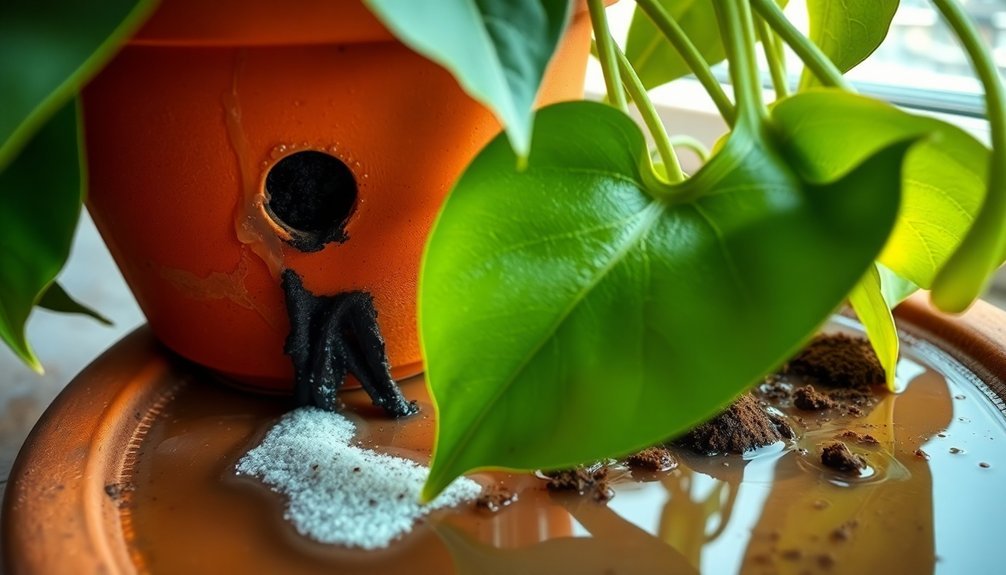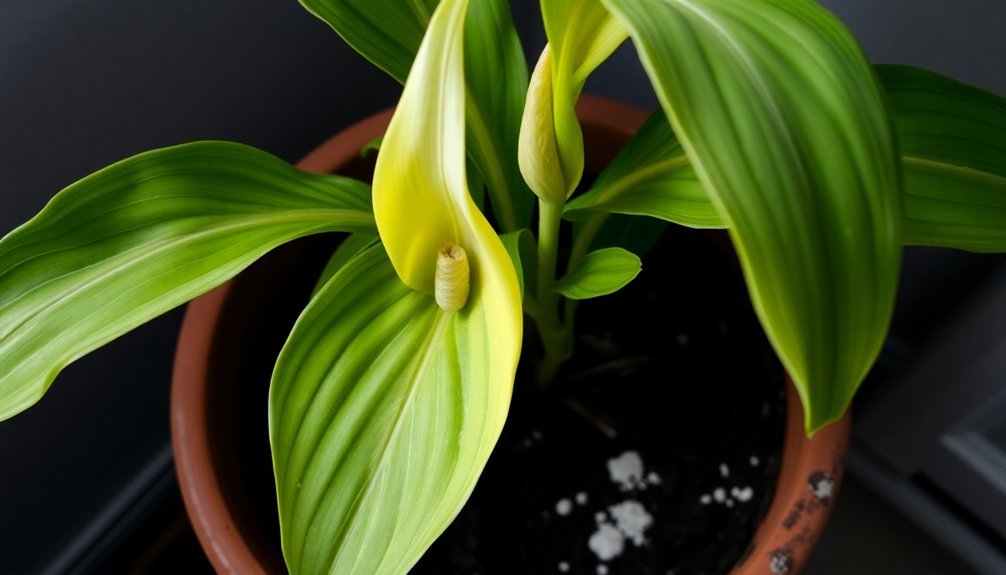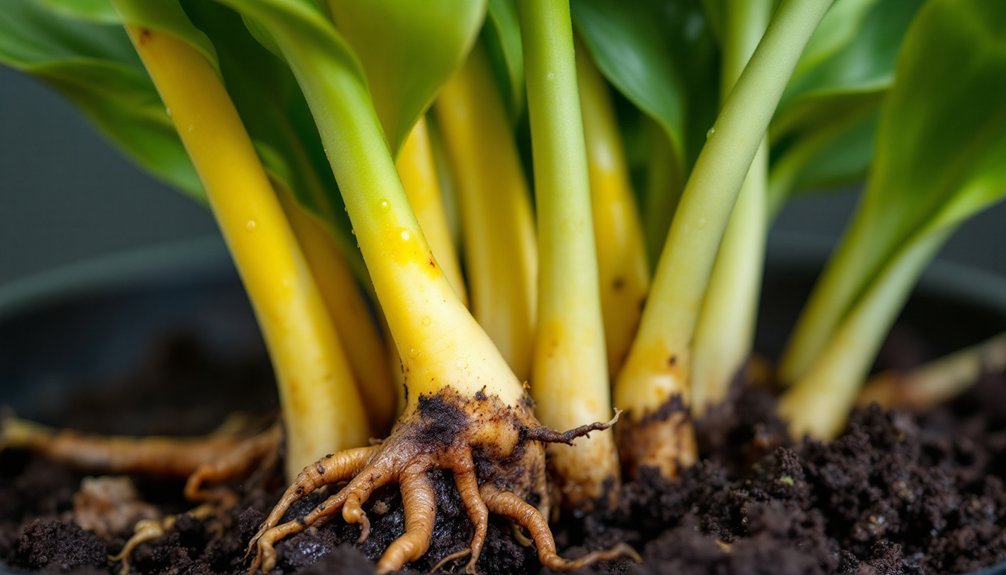Watch for these seven warning signs that your peace lily has rot: yellowing, drooping leaves even with regular watering; dark, mushy roots with a foul smell; soil that stays wet for days; black spots spreading on leaves and stems; stunted growth with fewer new leaves; brown or black root tips; and wilting that doesn't improve after watering. Understanding these signals can help you save your plant before the damage becomes permanent.
Yellow and Drooping Leaves Despite Regular Watering

While drooping leaves might tempt you to water your peace lily more frequently, yellow and wilting foliage combined with regular watering often points to root rot rather than dehydration.
When you notice your peace lily's leaves yellowing despite proper watering, it's essential to understand that the roots may be struggling to absorb nutrients due to decay.
Yellow leaves on a properly watered peace lily often signal root decay, preventing essential nutrients from reaching the plant.
Overwatering is a primary culprit of root rot, and your plant's drooping leaves are sending you a clear distress signal.
If your soil feels consistently soggy or appears compacted, it's likely causing poor drainage that's damaging the root system.
Don't wait to take action – when you spot these signs of root rot, carefully inspect the roots.
Early detection can save your peace lily from severe decline and help you adjust your watering routine accordingly.
Dark, Mushy Roots With Foul Odor
A telltale sign of severe root rot in your peace lily is the presence of dark, mushy roots accompanied by an unmistakable foul odor.
When you inspect your plant's root system, you'll notice affected roots appear black and slimy, drastically different from healthy roots, which should be firm and white. This condition typically results from overwatering and poor drainage, creating an environment where decay thrives.
If you detect these signs of root rot, don't wait to take action. The foul odor you're smelling indicates significant microbial activity and decomposition in the root zone.
This deterioration severely compromises your plant's nutrient uptake, eventually leading to complete plant failure. Regular root inspections are vital for catching these issues early, giving you the best chance to save your peace lily before extensive damage occurs.
Soil That Stays Wet for Days

Before root rot becomes visible in the roots themselves, persistent wet soil often serves as an early warning sign of trouble. If you notice your Peace Lily's soil staying wet for days after watering, you're likely dealing with overwatering issues that can lead to root rot.
| Time After Watering | Healthy Soil | Warning Signs |
|---|---|---|
| Day 1 | Moist but not soggy | Standing water |
| Day 2 | Slightly drying | Still wet to touch |
| Day 3 | Top inch drying | Consistently wet |
| Day 4 | Ready for water | Soggy throughout |
Check your moisture levels regularly and verify proper drainage holes in your pot. When soggy soil persists, it restricts oxygen to the roots, creating unhealthy root conditions. Watch for yellowing leaves, which often appear when well-draining soil is compromised. These signs indicate you need to adjust your watering routine before severe root rot develops.
Black Spots Spreading on Leaves and Stems
When dark spots begin appearing on your Peace Lily's leaves and stems, you're likely witnessing a serious symptom of root rot.
These black spots signal that your plant's suffering from overwatering and poor drainage, creating perfect conditions for fungal growth beneath the soil's surface.
You'll notice these spots spread quickly across your peace lily's foliage, turning mushy and causing leaves to droop and eventually fall off.
While monitoring your plant, pay attention to any foul odor coming from the soil – it's a telltale sign that roots are decaying.
If you spot these symptoms early, you've got a better chance of saving your plant.
Consider repotting immediately and adjusting your watering schedule to prevent further damage to your peace lily's root system.
Stunted Growth and Fewer New Leaves

Beyond visible leaf damage, root rot takes a serious toll on your peace lily's overall development.
When you notice stunted growth and fewer new leaves, it's often a clear warning that your plant's root system is failing. Healthy roots support steady new leaf growth, but when rot sets in, this essential process slows or stops completely.
You'll want to pay close attention to your peace lily's growth patterns, as monitoring new leaf production can help you catch root problems early.
If you're providing proper care but your plant isn't producing new leaves, check for black mushy roots – a telltale sign of rot. Overwatering is typically the culprit behind these underlying root health issues, as waterlogged soil prevents roots from getting the oxygen they need to thrive.
Root Tips Turning Brown or Black
When you check your peace lily's roots, healthy tips should be white or light tan, so any browning or blackening serves as a critical early warning of root rot.
You'll notice affected root tips becoming mushy and changing from their normal firm texture to a darker, decayed appearance.
These color changes typically start at the tips and can spread upward through the root structure, making early detection essential for saving your plant.
Early Warning Color Changes
Color changes in your peace lily's root tips serve as vital warning signs of developing root rot. When you're examining your plant, healthy roots should appear white and firm. If you notice black or brown discoloration, you're likely dealing with root rot caused by overwatering.
| Warning Sign | What It Means |
|---|---|
| Brown Tips | Early decay |
| Black Roots | Severe rot |
| Foul Smell | Active decay |
| Turning Yellow | Root damage |
Early detection of these changes is essential for your peace lily's survival. Pay attention to new growth – if it's turning black at the tips, your roots aren't functioning properly. When you spot these signs, implement corrective measures immediately. This includes adjusting your watering schedule and potentially repotting with fresh soil to prevent further deterioration.
Root Structure Decay Patterns
Root tip deterioration follows distinct patterns that you'll need to recognize for effective treatment. When checking your peace lily's roots, you'll notice healthy roots appear white and stringy, while discolored root tips signal trouble. Brown or black tips indicate root rot's progression, hampering nutrient absorption and oxygen uptake. Early detection is vital since decay typically moves upward through the root structure.
- Root tips turning brown or black feel mushy or slimy to the touch
- Discoloration starts at the tips before spreading to the entire root system
- Affected areas show clear contrast against healthy white roots
- Poor soil drainage accelerates the decay process
If you spot these warning signs, immediately trim affected roots and improve soil drainage. Taking swift action prevents further decay while promoting healthier root growth, giving your peace lily the best chance at recovery.
Wilting That Doesn't Improve After Watering

A peace lily's persistent wilting despite regular watering serves as a telltale sign of root rot. When your plant's roots are decaying, they can't effectively absorb water, leaving the leaves drooping even after you've moistened the soil. This is different from normal wilting, where your peace lily would typically perk up soon after watering.
You'll want to watch for additional symptoms that confirm root rot. If you notice yellowing leaves alongside the persistent wilting, or detect an unpleasant odor from the soil, your plant is likely suffering from root decay.
Keep in mind that healthy peace lilies should respond to watering with restored turgor pressure, making their leaves firm again. Early detection through regular monitoring can help you save your plant before the root rot becomes too severe.
Frequently Asked Questions
How to Tell if Peace Lily Has Root Rot?
You'll notice black, mushy roots with a foul smell coming from the soil. Watch for yellowing leaves, wilting despite watering, and droopy foliage. Check for stunted growth and black spots on leaves.
What Does an Unhealthy Peace Lily Look Like?
You'll notice your unhealthy peace lily has yellowing or drooping leaves, even with regular watering. The plant might show stunted growth, black-tipped leaves, and you'll smell something foul coming from the soil.
How to Fix Leaf Rot on Peace Lily?
Remove affected leaves, don't overwater, and let soil dry between waterings. You'll need to repot in fresh, well-draining soil, trim damaged roots, and apply fungicide. Keep your plant in bright, indirect light afterwards.
How Long Does Peace Lily Take to Recover From Root Rot?
You'll need to be patient, as your peace lily typically takes 3-4 weeks to show initial recovery signs and up to 3 months for full recovery, depending on how severe the root rot was.
In Summary
If you've noticed any of these signs in your peace lily, you're likely dealing with root rot. Don't wait to take action – immediately remove the plant from its pot, trim away affected roots, and repot in fresh, well-draining soil. By catching these symptoms early and addressing the underlying drainage issues, you'll give your peace lily the best chance at recovery.





Leave a Reply